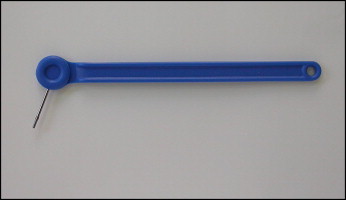Ingestion of a foreign object, including a dental object, can lead to a trip to the emergency room. This article describes the accidental swallowing of a key that was used to activate a rapid maxillary expander. An orthodontic patient swallowed the key while trying to activate the appliance at home. The object’s trajectory was followed on radiographs until it was eliminated. Possible clinical complications, legal implications of this situation, and practices for prevention are described.
The ingestion of a foreign object is a complication often seen in the hospital emergency rooms. The dental department, where instruments and products are manipulated inside the mouth, is an environment of risk. Dental objects that have been swallowed include dental prostheses and endodontic instruments. The ingested object can pass through the gastrointestinal tract uneventfully, but it can sometimes cause serious complications. Treatment depends on the type and size of the object and its location.
During dental treatment, we must be aware of practices that decrease the risk of accidentally swallowing an object. In the doctor’s office, patients must be guided to prevent such occurrences.
The purpose of this article is to describe a clinical case of accidental deglutition of the key used to activate a rapid maxillary expansion appliance. Some clinical and legal implications are discussed, mainly emphasizing the care needed to prevent such an accident.
Case report
A 9-year-old boy arrived at the emergency service of the hospital after he swallowed the key for his Haas rapid maxillary expansion appliance. The parents reported that the key slipped during the activation of the appliance that day at home. The child was not in discomfort nor did he have signs of asphyxia or vomiting. The frontal x-ray of the abdomen confirmed the presence of the key in the stomach ( Fig 1 ). The child did not have a history of swallowing objects or of surgeries in the gastrointestinal tract. Thus, a fiber-rich diet was recommended to facilitate natural elimination of the key. Two days later, the abdominal x-ray showed that the key had moved into the region of the sigmoid colon ( Fig 2 ).


The parents were advised to return to the hospital after 2 days for a third x-ray. On the same day, however, the parents confirmed that the key was in the child’s excrement. An occult blood test was negative, suggesting no bleeding in the intestine. The patient was followed, and treatment concluded without new implications.
Discussion
Objects can be accidentally inhaled or swallowed. The most serious situation is when they are inhaled, with the possibility of suffocating. In such cases, surgical intervention is often required. Although this is more serious than deglutition, it is less common and normally affects small children, or unconscious, mentally ill, or disabled people whose coordination or control of deglutition is impaired. When foreign objects are swallowed, they can lodge in the throat, esophagus, stomach, intestine, or simply transit through the gastrointestinal tract and then be eliminated in the excrement. This procedure is generally is indicated for asymptomatic patients with nonaggressive object deglutition, without respiratory symptoms, and with no history of illnesses or surgeries in the gastrointestinal tract. Normally, when the object reaches the stomach, it has a 90% possibility of passing through the gastrointestinal tract without problems. About 10% to 20% do not require surgical intervention, and less than 1% need surgical intervention. The risk of injury increases when the swallowed object is greater than 5 cm or has a pointed shape. The situation must be followed carefully, with a series of radiographs if the patient remains asymptomatic and, if the object is radiopaque, until it is found in the excrement. Our patient did not report discomfort during this time, and the radiographs demonstrated that the object was transiting through the gastrointestinal tract normally.
When objects are lodged in the gastrointestinal tract, some type of intervention is necessary, such as endoscopy or surgery, to prevent abscesses, perforations, and mediastinitis. If the object remains motionless for 3 days in the intestine or 1 week in the stomach, surgery is required.
Beyond the medical complications, this situation can lead to the loss of professional credibility or litigation. A patient might need only to document that he or she suffered some form of damage to bring a legal claim against the dentist. The dentist must demonstrate that he or she was not at fault. If there was evidence of recklessness on the part of the dentist, he or she can be liable both criminally and civilly for the actual damages. Even if the patient does not take legal action against the dentist, such an event can result in ineffective treatments or reduced patient cooperation because of distrust.
The best option is to prevent accidents. For rapid maxillary expansion activation keys, some steps must be followed. The first is to use dental floss tied around the key and then rolled up on the finger to allow ready recovery in case of deglutition or aspiration. This is already practiced for other dental objects such as tranpalatal arches, bands, and protheses. Another possibility is to use a key that is connected to a plastic spatula or handle ( Fig 3 ).





